Recovery of Magnesium from Ferronickel Slag to Prepare Magnesium Oxide by Sulfuric Acid Leaching
Abstract
1. Introduction
2. Materials and Methods
2.1. Materials
2.2. Methods
2.2.1. Sulfuric Acid Leaching
2.2.2. Purification of Magnesium
2.2.3. Preparation of Magnesium Oxide
2.3. Characterization Methods
3. Results and Discussion
3.1. The Acid Leaching Process of Ferronickel Slag
3.2. Analysis of the Leaching Residues
3.3. Response Surface Optimization
3.4. Analysis of Leaching Kinetics
3.5. Purification of Magnesium
3.6. Preparation of Magnesium Oxide
4. Conclusions
Supplementary Materials
Author Contributions
Funding
Acknowledgments
Conflicts of Interest
References
- Luo, J.; Li, G.; Rao, M.; Zhang, Y.; Peng, Z.; Zhi, Q.; Jiang, T. Evaluation of Sintering Behaviors of Saprolitic Nickeliferous Laterite Based on Quaternary Basicity. JOM 2015, 67, 1966–1974. [Google Scholar] [CrossRef]
- Saha, A.K.; Sarker, P.K. Expansion due to alkali-silica reaction of ferronickel slag fine aggregate in OPC and blended cement mortars. Constr. Build. Mater. 2016, 123, 135–142. [Google Scholar] [CrossRef]
- Peng, Z.; Wang, L.; Gu, F.; Tang, H.; Rao, M.; Zhang, Y.; Li, G.; Jiang, T. Recovery of chromium from ferronickel slag: A comparison of microwave roasting and conventional roasting strategies. Powder Technol. 2020, 372, 578–584. [Google Scholar] [CrossRef]
- Zhang, Z.; Zhu, Y.; Yang, T.; Li, L.; Zhu, H.; Wang, H. Conversion of local industrial wastes into greener cement through geopolymer technology: A case study of high-magnesium nickel slag. J. Clean. Prod. 2017, 141, 463–471. [Google Scholar] [CrossRef]
- Saha, A.K.; Sarker, P.K. Sustainable use of ferronickel slag fine aggregate and fly ash in structural concrete: Mechanical properties and leaching study. J. Clean. Prod. 2017, 162, 438–448. [Google Scholar] [CrossRef]
- Choi, Y.C.; Choi, S. Alkali-silica reactivity of cementitious materials using ferro-nickel slag fine aggregates produced in different cooling conditions. Constr. Build. Mater. 2015, 99, 279–287. [Google Scholar] [CrossRef]
- Saha, A.K.; Sarker, P.K.; Golovanevskiy, V. Thermal properties and residual strength after high temperature exposure of cement mortar using ferronickel slag aggregate. Constr. Build. Mater. 2019, 199, 601–612. [Google Scholar] [CrossRef]
- Pan, J.; Zheng, G.L.; Zhu, D.Q.; Zhou, X.L. Utilization of nickel slag using selective reduction followed by magnetic separation. Trans. Nonferrous Met. Soc. China 2013, 23, 3421–3427. [Google Scholar] [CrossRef]
- Komnitsas, K.; Zaharaki, D.; Bartzas, G. Effect of sulphate and nitrate anions on heavy metal immobilisation in ferronickel slag geopolymers. Appl. Clay Sci. 2013, 73, 103–109. [Google Scholar] [CrossRef]
- Ljatifi, E.; Kamusheva, A.; Grozdanov, A.; Paunović, P.; Karamanov, A. Optimal thermal cycle for production of glass–ceramic based on wastes from ferronickel manufacture. Ceram. Int. 2015, 41, 11379–11386. [Google Scholar] [CrossRef]
- Karamanov, A.; Paunović, P.; Ranguelov, B.; Ljatifi, E.; Kamusheva, A.; Načevski, G.; Karamanova, E.; Grozdanov, A. Vitrification of hazardous Fe-Ni wastes into glass-ceramic with fine crystalline structure and elevated exploitation characteristics. J. Environ. Chem. Eng. 2017, 5, 432–441. [Google Scholar] [CrossRef]
- Wang, W.; Chen, J.; Yu, J.; Zhou, L.; Dai, S.; Tian, W. Adjusting the melting and crystallization behaviors of ferronickel slag via partially replacing of SiO2 by B2O3 for mineral wool production. Waste Manag. 2020, 111, 34–40. [Google Scholar] [CrossRef]
- Gu, F.; Peng, Z.; Zhang, Y.; Tang, H.; Ye, L.; Tian, W.; Liang, G.; Rao, M.; Li, G.; Jiang, T. Facile Route for Preparing Refractory Materials from Ferronickel Slag with Addition of Magnesia. ACS Sustain. Chem. Eng. 2018, 6, 4880–4889. [Google Scholar] [CrossRef]
- Peng, Z.; Tang, H.; Augustine, R.; Lee, J.; Tian, W.; Chen, Y.; Gu, F.; Zhang, Y.; Li, G.; Jiang, T. From ferronickel slag to value-added refractory materials: A microwave sintering strategy. Resour. Conserv. Recycl. 2019, 149, 521–531. [Google Scholar] [CrossRef]
- Gu, F.; Peng, Z.; Zhang, Y.; Tang, H.; Tian, W.; Lee, J.; Rao, M.; Li, G.; Jiang, T. Promoting spinel formation and growth for preparation of refractory materials from ferronickel slag. Int. J. Appl. Ceram. Technol. 2020, 17, 1701–1712. [Google Scholar] [CrossRef]
- Liu, K. The Study on the Preparation of Forsterite Refractories from High Magnesium Nickel Slag; University of Science and Technology: Beijing, China, 2018; pp. 1–76. [Google Scholar]
- Wang, Y.; Zhu, R.; Chen, Q.; Wei, G.; Hu, S.; Guo, Y. Recovery of Fe, Ni, Co, and Cu from nickel converter slag through oxidation and reduction. ISIJ Int. 2018, 58, 2191–2199. [Google Scholar] [CrossRef]
- Huang, F.; Liao, Y.; Zhou, J.; Wang, Y.; Li, H. Selective recovery of valuable metals from nickel converter slag at elevated temperature with sulfuric acid solution. Sep. Purif. Technol. 2015, 156, 572–581. [Google Scholar] [CrossRef]
- Tian, D.; Shen, X.; Zhai, Y.; Xiao, P.; Webley, P. Extraction of iron and aluminum from high-iron bauxite by ammonium sulfate roasting and water leaching. J. Iron Steel Res. Int. 2019, 26, 578–584. [Google Scholar] [CrossRef]
- Zhai, X.J.; Li, N.J.; Zhang, X.; Fu, Y.; Jiang, L. Recovery of cobalt from converter slag of Chambishi Copper Smelter using reduction smelting process. Trans. Nonferrous Met. Soc. China 2011, 21, 2117–2121. [Google Scholar] [CrossRef]
- Li, Y.; Perederiy, I.; Papangelakis, V.G. Cleaning of waste smelter slags and recovery of valuable metals by pressure oxidative leaching. J. Hazard. Mater. 2008, 152, 607–615. [Google Scholar] [CrossRef]
- Gbor, P.K.; Ahmed, I.B.; Jia, C.Q. Evaluation of contributions of acid and ligand to Ni, Co, and Fe dissolution from nonferrous smelter slags in aqueous sulfur dioxide. Ind. Eng. Chem. Res. 2002, 41, 1861–1867. [Google Scholar] [CrossRef]
- Perederiy, I.; Papangelakis, V.G.; Buarzaiga, M.; Mihaylov, I. Co-treatment of converter slag and pyrrhotite tailings via high pressure oxidative leaching. J. Hazard. Mater. 2011, 194, 399–406. [Google Scholar] [CrossRef] [PubMed]
- Curlook, W.; Baghalha, M.; Papangelakis, V.; Curlook, W.; Baghalha, M.; Papangelakis, V. Process for the Recovery of Residual Metal Values from Smelter Waste Slags, and from Converter Slags. CA2363969 C, 13 January 2001. [Google Scholar]
- Altinkaya, P.; Mäkinen, J.; Kinnunen, P.; Kolehmainen, E.; Haapalainen, M.; Lundström, M. Effect of biological pretreatment on metal extraction from flotation tailings for chloride leaching. Miner. Eng. 2018, 129, 47–53. [Google Scholar] [CrossRef]
- Bulaev, A.G.; Muravyov, M.I.; Pivovarova, T.A.; Fomchenko, N.V.; Kondrat’eva, T.F. Bioprocessing of mining and metallurgical wastes containing nonferrous and precious metals. Adv. Mater. Res. 2013, 825, 301–304. [Google Scholar] [CrossRef]
- Zhang, X.; Gu, F.; Peng, Z.; Wang, L.; Tang, H.; Rao, M.; Zhang, Y.; Li, G.; Jiang, T.; Wang, Y. Recovering Magnesium from Ferronickel Slag by Vacuum Reduction: Thermodynamic Analysis and Experimental Verification. ACS Omega 2019, 4, 16062–16067. [Google Scholar] [CrossRef]
- Zhao, C.; Cai, Y.; Ning, Z.; Wang, G.; Kang, S.; Zhang, C.; Zhai, Y. Recovery of MgO from laterite nickel slag through roasting by ammonium sulfate. Zhongnan Daxue Xuebao (Ziran Kexue Ban)/J. Cent. South Univ. (Sci. Technol.) 2017, 48, 1972–1978. [Google Scholar] [CrossRef]
- Prasetyo, A.B.; Rahadian, D.; Mayangsari, W.; Febriana, E.; Permana, S.; Maksum, A.; Soesaptri, O.; Firdiyono, F.; Soedarsono, J.W. Reverse leaching of magnesium from ferronickel slag using alkali solvent naoh. Eastern-Eur. J. Enterp. Technol. 2020, 1, 6–14. [Google Scholar] [CrossRef][Green Version]
- Mubarok, M.Z.; Yudiarto, A. Synthesis of Magnesium Oxide from Ferronickel Smelting Slag through Hydrochloric Acid Leaching-—Precipitation and Calcination; Springer: Berlin/Heidelberg, Germany, 2017. [Google Scholar]
- Gao, F.; Huang, Z.; Li, H.; Li, X.; Wang, K.; Hamza, M.F.; Wei, Y.; Fujita, T. Recovery of magnesium from ferronickel slag to prepare hydrated magnesium sulfate by hydrometallurgy method. J. Clean. Prod. 2021, 303, 127049. [Google Scholar] [CrossRef]
- Linchuan, L. The Study on the Comprehensive Utilization and Recovery of Valuable Components from Electric Furnace Nickel-Iron Slag. Master’s Thesis, University of Science and Technology, Beijing, China, 2018; pp. 1–79. [Google Scholar]
- Bergmann, J.; Friedel, P.; Kleeberg, R. BGMN—A New Fundamental Parameters Based Rietveld Program for Laboratory X-ray Sources, it’s Use in Quantitative Analysis and Structure Investigations. IUCr Comm. Powder Diffr. Newsl. 1998, 20, 5–8. [Google Scholar]
- Xu, H.; Liu, W.P.; Yang, X.Y.; Shi, X.C.; Chen, S.Y.; Yu, L.L. Preparation of high-purity light magnesia from sulfate salt subtype salt lake brine. Zhongnan Daxue Xuebao (Ziran Kexue Ban)/J. Cent. South Univ. (Sci. Technol.) 2011, 42, 2204–2208. [Google Scholar]
- Huang, J.; Chen, M.; Chen, H.; Chen, S.; Sun, Q. Leaching behavior of copper from waste printed circuit boards with Brønsted acidic ionic liquid. Waste Manag. 2014, 34, 483–488. [Google Scholar] [CrossRef] [PubMed]
- Khatoon, H.; Rai, J.P.N. Optimization studies on biodegradation of atrazine by Bacillus badius ABP6 strain using response surface methodology. Biotechnol. Rep. 2020, 26, e00459. [Google Scholar] [CrossRef] [PubMed]
- Apostolidis, C.I.; Distin, P.A. The kinetics of the sulphuric acid leaching of nickel and magnesium from reduction roasted serpentine. Hydrometallurgy 1978, 3, 181–196. [Google Scholar] [CrossRef]
- Hollagh, A.R.E.; Alamdari, E.K.; Moradkhani, D.; Salardini, A.A. Kinetic Analysis of Isothermal Leaching of Zinc from Zinc Plant Residue. Int. J. Nonferrous Metall. 2013, 2, 10–20. [Google Scholar] [CrossRef][Green Version]
- Lin, Q.; Gu, G.; Wang, H.; Zhu, R.; Liu, Y.; Fu, J. Preparation of manganese sulfate from low-grade manganese carbonate ores by sulfuric acid leaching. Int. J. Miner. Metall. Mater. 2016, 23, 491–500. [Google Scholar] [CrossRef]


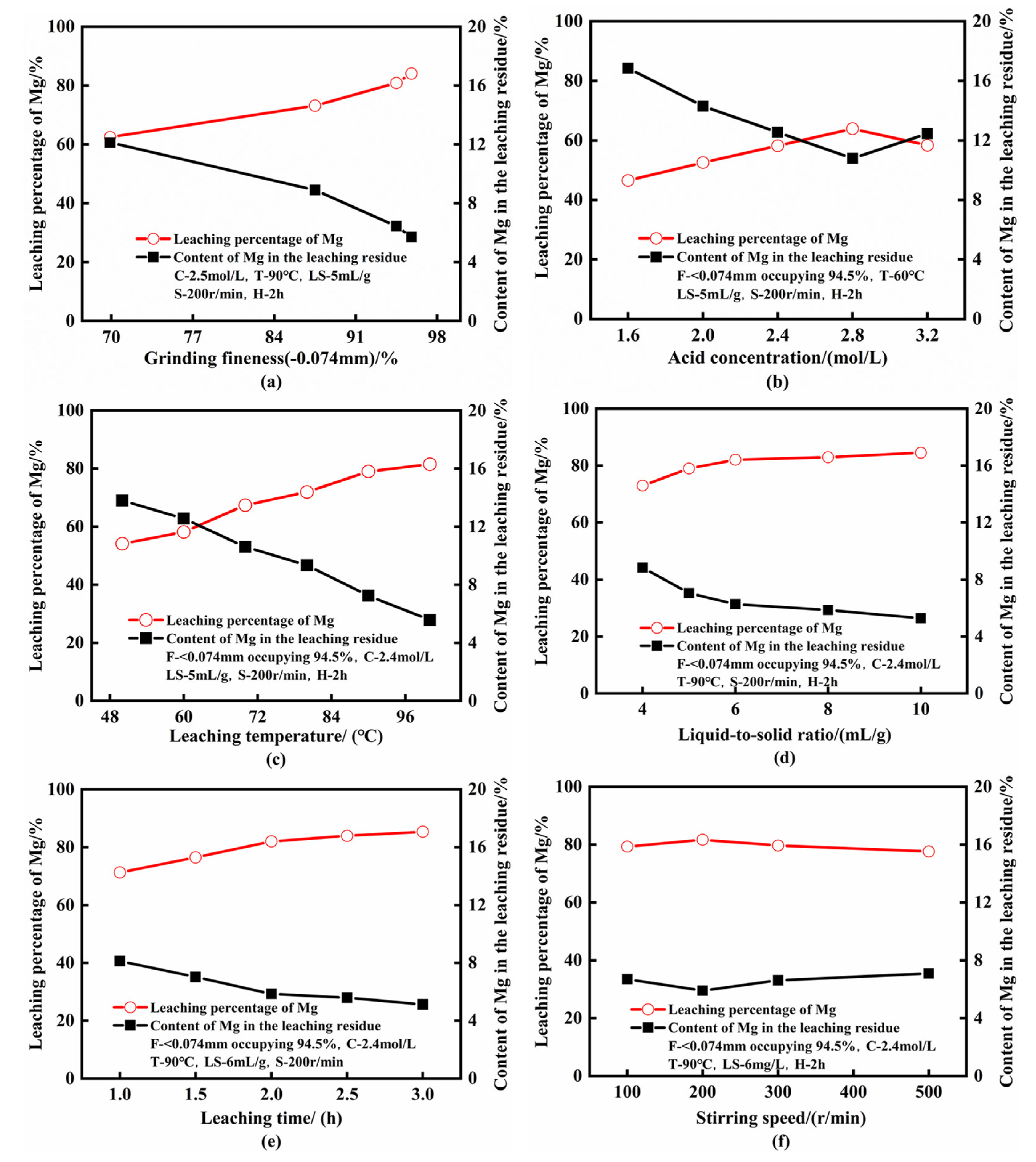
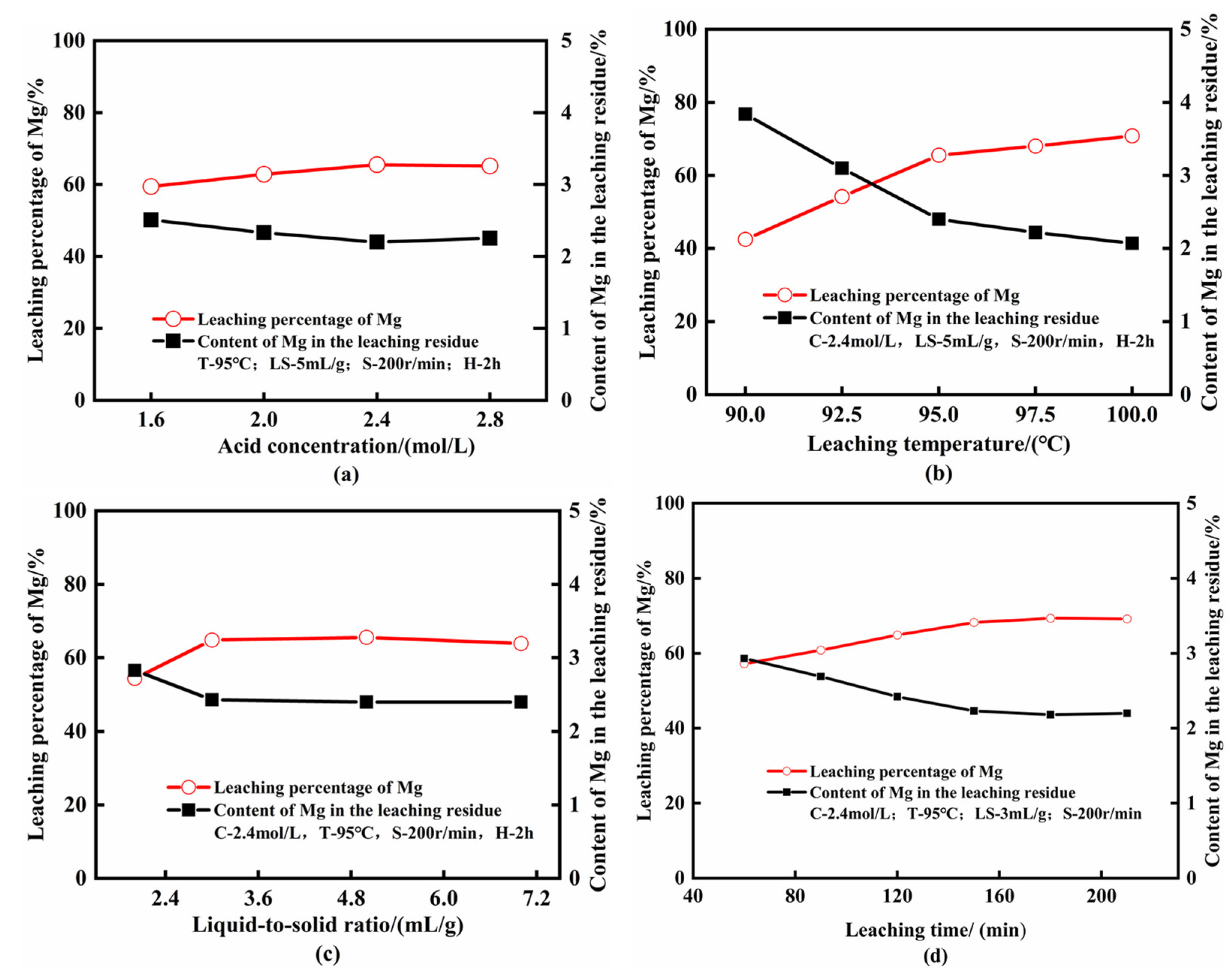
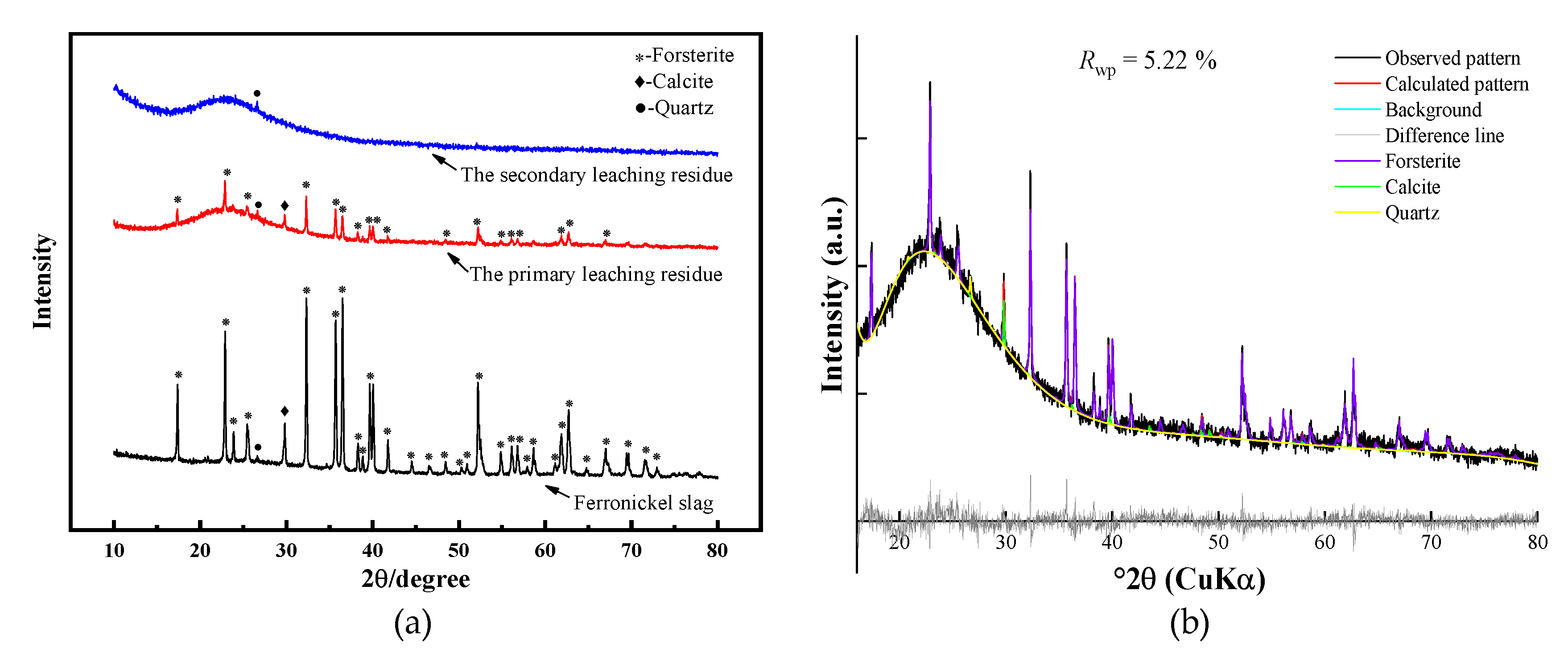

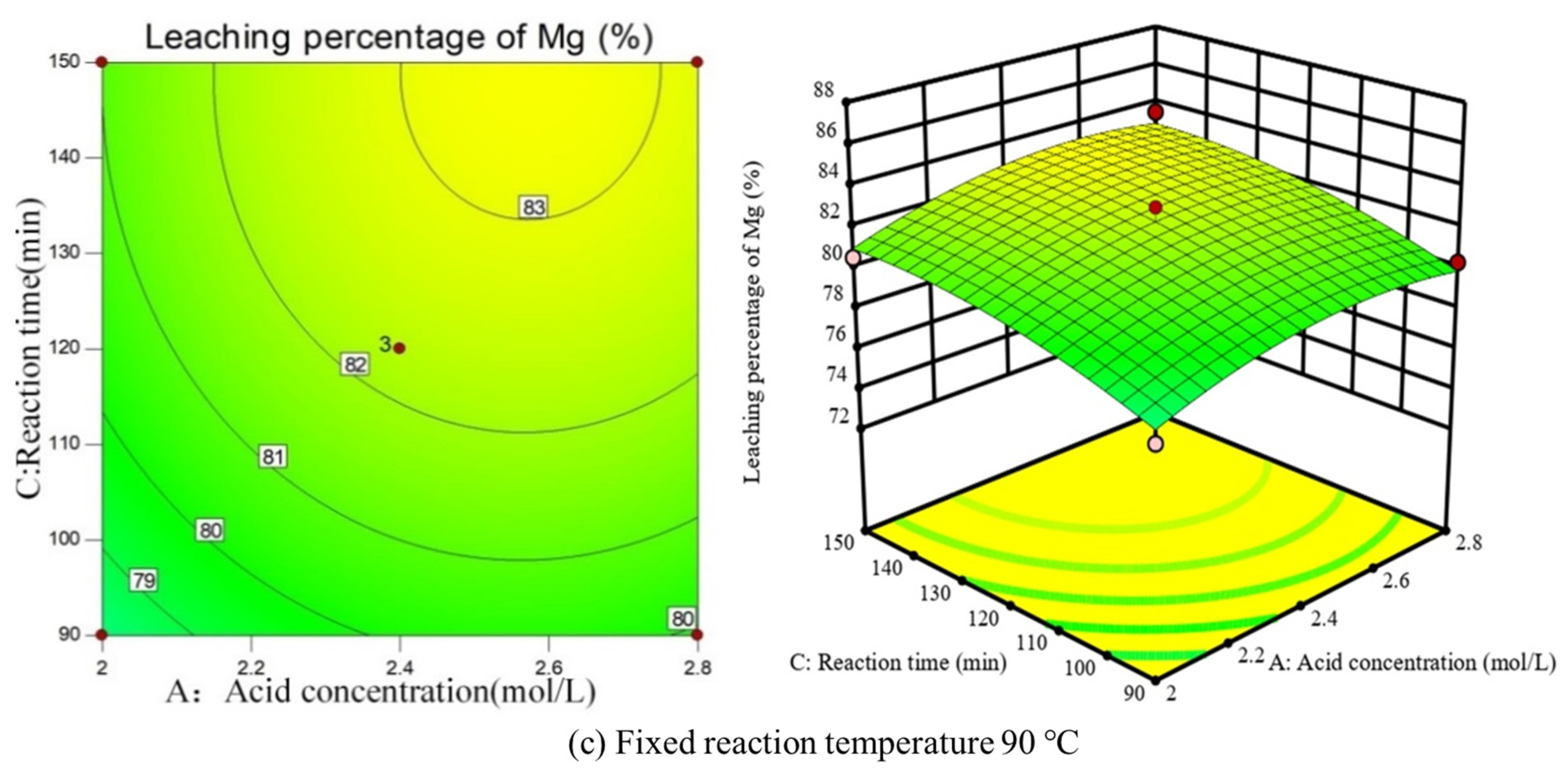
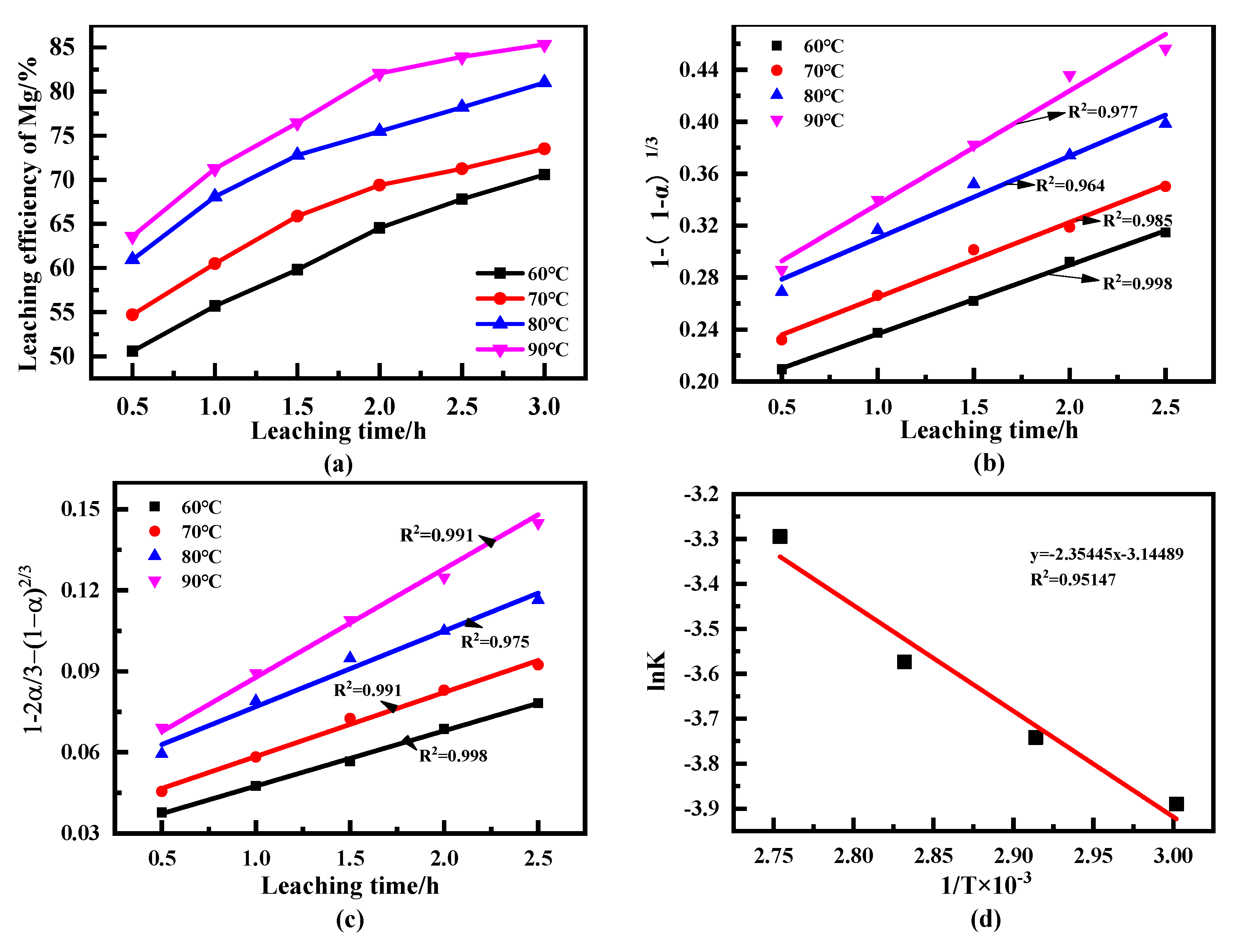

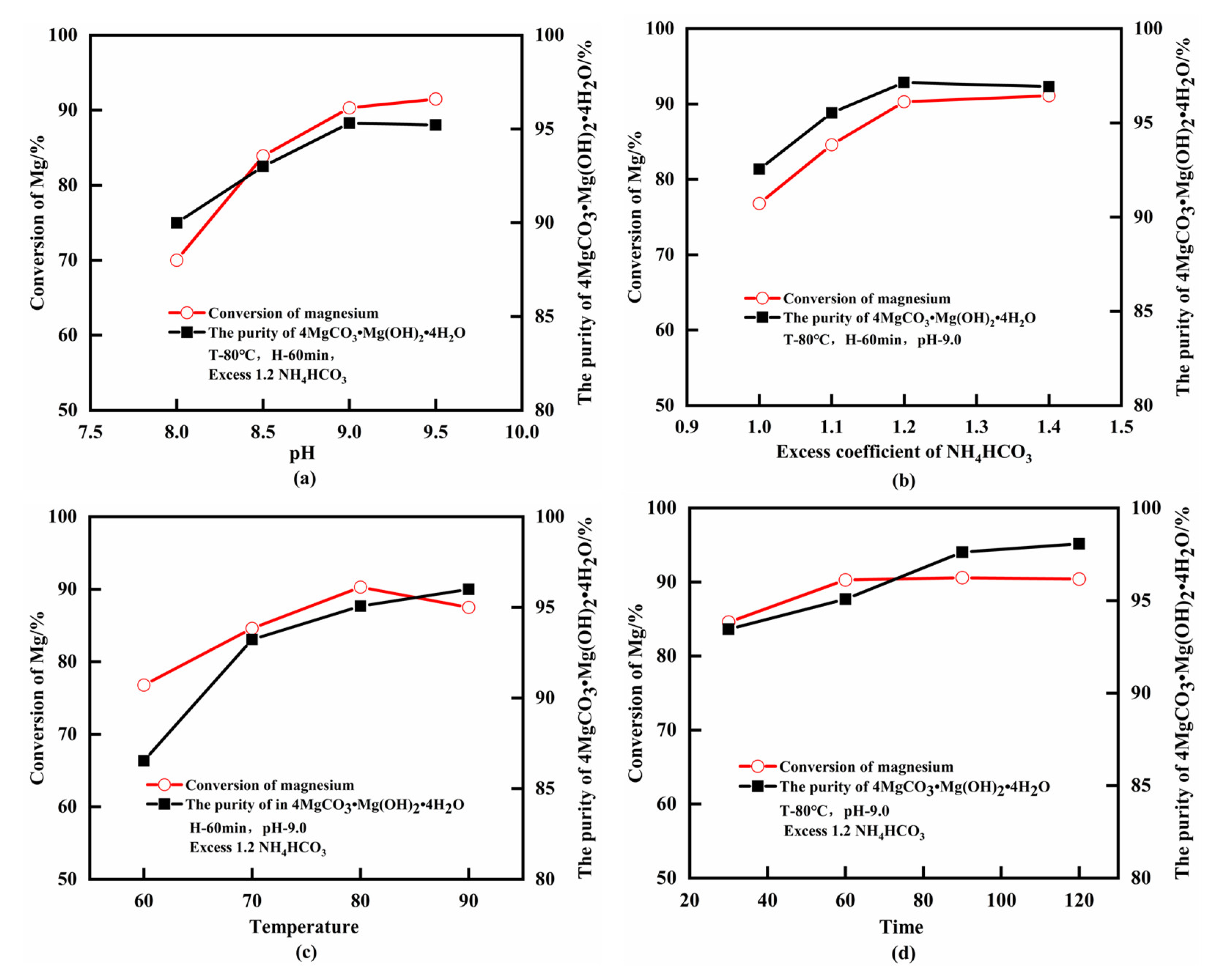
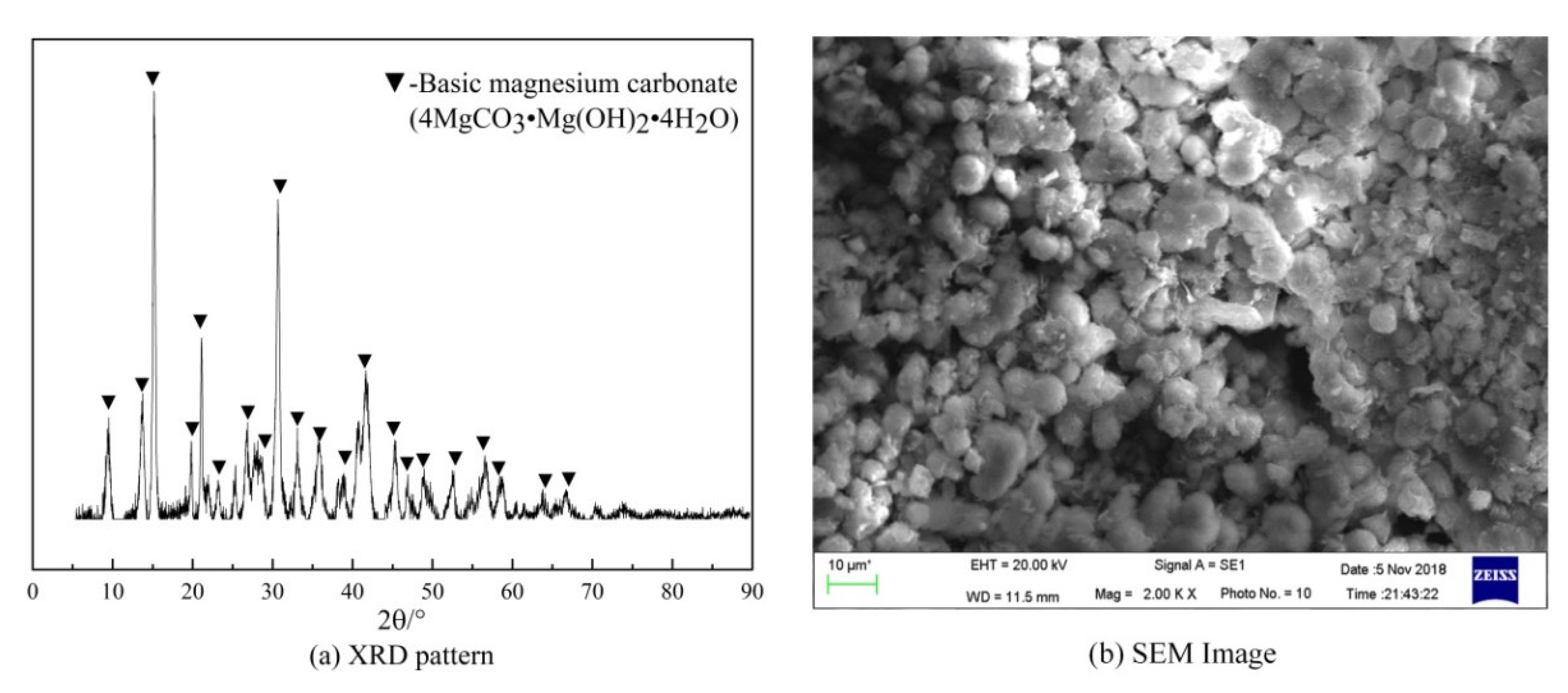

| SiO2 | MgO | Fe2O3 | CaO | Al2O3 | Cr2O3 | MnO | TiO2 | K2O | Na2O | NiO | Others |
|---|---|---|---|---|---|---|---|---|---|---|---|
| 44.39 | 36.12 | 8.26 | 4.89 | 4.31 | 0.98 | 0.49 | 0.12 | 0.10 | 0.11 | 0.04 | 0.91 |
| Component | SiO2 | CaO | MgO | Fe2O3 | Al2O3 | Cr2O3 | MnO | TiO2 | K2O | Na2O | NiO |
|---|---|---|---|---|---|---|---|---|---|---|---|
| The primary | 80.73 | 5.71 | 4.17 | 4.17 | 3.56 | 0.69 | 0.32 | 0.15 | 0.12 | 0.11 | 0.02 |
| The secondary | 84.20 | 5.54 | 2.28 | 3.32 | 3.14 | 0.59 | 0.27 | 0.13 | 0.11 | 0.09 | 0.01 |
| Code | Variables | Unit | Level | Factor | ||||
|---|---|---|---|---|---|---|---|---|
| A | acid concentration | mol/L | 2.0 | 2.4 | 2.8 | −1 | 0 | +1 |
| B | reaction temperature | °C | 80 | 90 | 100 | −1 | 0 | +1 |
| C | reaction time | min | 90 | 120 | 150 | −1 | 0 | +1 |
| Number | Variables | Leaching Percentage of Mg/% | ||
|---|---|---|---|---|
| A | B | C | ||
| 1 | 2.8 | 90 | 150 | 83.49 |
| 2 | 2.4 | 100 | 90 | 84.78 |
| 3 | 2 | 100 | 120 | 83.67 |
| 4 | 2.4 | 90 | 120 | 82.05 |
| 5 | 2.4 | 100 | 150 | 86.77 |
| 6 | 2.8 | 80 | 120 | 76.04 |
| 7 | 2 | 80 | 120 | 75.26 |
| 8 | 2.4 | 80 | 90 | 72.78 |
| 9 | 2.8 | 100 | 120 | 84.35 |
| 10 | 2.4 | 90 | 120 | 81.85 |
| 11 | 2.8 | 90 | 90 | 80.33 |
| 12 | 2 | 90 | 150 | 80.56 |
| 13 | 2.4 | 80 | 150 | 76.22 |
| 14 | 2 | 90 | 90 | 77.56 |
| 15 | 2.4 | 90 | 120 | 83.01 |
| Source | Sum of Square | Degree of Freedom | Mean Square | F-Value | p-Value | Significance Level |
|---|---|---|---|---|---|---|
| Model | 228.48 | 9 | 25.39 | 17.31 | 0.0029 | significant |
| A-Acid concentration | 6.41 | 1 | 6.41 | 4.37 | 0.0908 | |
| B-Reactiontemperature | 192.77 | 1 | 192.77 | 131.46 | <0.0001 | |
| C-Reaction time | 16.79 | 1 | 16.79 | 11.45 | 0.0196 | |
| AB | 0.0025 | 1 | 0.0025 | 0.0017 | 0.9687 | |
| AC | 0.0064 | 1 | 0.0064 | 0.0044 | 0.9499 | |
| BC | 0.5256 | 1 | 0.5256 | 0.3585 | 0.5754 | |
| A² | 4.17 | 1 | 4.17 | 2.84 | 0.1525 | |
| B² | 7.35 | 1 | 7.35 | 5.01 | 0.0754 | |
| C² | 2.11 | 1 | 2.11 | 1.44 | 0.2843 | |
| Residual | 7.33 | 5 | 1.47 | |||
| Lack of Fit | 6.56 | 3 | 2.19 | 5.69 | 0.1531 | not significant |
| Pure Error | 0.7691 | 2 | 0.3845 | |||
| Cor Total | 235.81 | 14 |
| Metal Ion | Mg2+ | Fe2+/Fe3+ | Al3+ | Cr3+ | Mn2+ |
|---|---|---|---|---|---|
| Concentration | 9.76 | 1.72 | 0.8–0.6 | 0.2–0.1 | <0.1 |
| Ions | Fe3+ | Al3+ | Cr3+ | Fe2+ | Mn2+ | Mg2+ |
|---|---|---|---|---|---|---|
| pH | 1.5–3.5 | 3.1–5.1 | 4–7 | 6.3–9.3 | 7.4–10.4 | 8.4–11.4 |
| Component | Fe2O3 | Al2O3 | SiO2 | MgO | CaO | MnO | Cr2O3 | SO3 | Others |
|---|---|---|---|---|---|---|---|---|---|
| Content | 44.48 | 11.06 | 2.92 | 10.06 | 0.64 | 1.03 | 4.80 | 24.77 | 0.24 |
| Project | MgO /% | CaO /% | HCl Insoluble/% | Sulfate /% | 150 μm Residue on Sieve/% | Fe /% | Mn /% | Loss on Ignition/% | Bulk Density /(g/mL) |
|---|---|---|---|---|---|---|---|---|---|
| First-class | ≥93.0 | ≤1.5 | ≤0.20 | ≤0.6 | ≤0.03 | ≤0.06 | ≤0.01 | ≤5.0 | ≤0.20 |
| Product | 94.85 | 0.8 | trace | 0.48 | trace | 0.014 | 0.008 | 3.10 | 0.16 |
Publisher’s Note: MDPI stays neutral with regard to jurisdictional claims in published maps and institutional affiliations. |
© 2021 by the authors. Licensee MDPI, Basel, Switzerland. This article is an open access article distributed under the terms and conditions of the Creative Commons Attribution (CC BY) license (https://creativecommons.org/licenses/by/4.0/).
Share and Cite
Yang, J.; Duan, X.; Liu, L.; Yang, H.; Jiang, X. Recovery of Magnesium from Ferronickel Slag to Prepare Magnesium Oxide by Sulfuric Acid Leaching. Minerals 2021, 11, 1375. https://doi.org/10.3390/min11121375
Yang J, Duan X, Liu L, Yang H, Jiang X. Recovery of Magnesium from Ferronickel Slag to Prepare Magnesium Oxide by Sulfuric Acid Leaching. Minerals. 2021; 11(12):1375. https://doi.org/10.3390/min11121375
Chicago/Turabian StyleYang, Juan, Xuqin Duan, Lingchuan Liu, Huifen Yang, and Xiaocui Jiang. 2021. "Recovery of Magnesium from Ferronickel Slag to Prepare Magnesium Oxide by Sulfuric Acid Leaching" Minerals 11, no. 12: 1375. https://doi.org/10.3390/min11121375
APA StyleYang, J., Duan, X., Liu, L., Yang, H., & Jiang, X. (2021). Recovery of Magnesium from Ferronickel Slag to Prepare Magnesium Oxide by Sulfuric Acid Leaching. Minerals, 11(12), 1375. https://doi.org/10.3390/min11121375





